Most of the time I focus on colorful landscapes and seascapes, but this post is a change of theme. I will be taking a closer look at some of the most dramatic paintings I have come across.
These paintings demonstrate just how powerful art can be and how much emotion we are able to depict as artists. Even if you prefer to paint colorful and pleasant scenes like me, there is still much to learn from the techniques used in these dramatic paintings. Just think about how you can use these techniques to depict happiness, joy or whatever other emotions you are trying to promote in your paintings.
Warning: This post is not for the faint-hearted. Some of these paintings are very confronting.
- Andrew Wyeth, Christina’s World, 1948
- Claude Monet, Camille on Her Deathbed, 1879
- Edgar Degas, L’Absinthe, 1875-1876
- Edvard Munch, the Sick Child (Det Syke Barn), 1885
- Edward Hopper, Automat, 1927
- Francis Bacon, Businessman I, 1952 or Man’s Head, 1952
- Frederick McCubbin, Pioneer, 1904
- Pablo Picasso, Old Guitarist, 1903
- Ilya Repin, Ivan the Terrible and His Son Ivan, 1885
- Vincent van Gogh, Sorrowing Old Man (At Eternity’s Gate), 1890
- Key Takeaways
- Want to Learn More?
- Thanks for Reading!
Andrew Wyeth, Christina’s World, 1948

This dramatic painting by Andrew Wyeth depicts the lonely and challenging nature of “Christina’s world”. Christina is a young girl who appears to be stranded in the middle of a field, looking up at a house in the distance. It is believed she suffered from a neuromuscular disease preventing her from walking.
Wyeth painted with a high level of detail and a dull palette of colors. Many have referred to this style of painting as “magic realism”.
Claude Monet, Camille on Her Deathbed, 1879

Claude Monet’s painting above is in stark contrast to the colorful and energetic landscapes which we are more familiar with. It captures the last moments of his wife on her deathbed. She died at the young age of 32, after suffering various medical conditions.
Monet said to a friend about this painting…
“You cannot know… the obsession, the joy, the torment of my days… I was at the deathbed of a lady who had been, and still was very dear to me…I found myself staring at [her] tragic countenance, automatically trying to identify things like the proportions of light”.
He painted in his usual style – broken color to capture the fleeting nature of life. There appears to be an open window illuminating his wife from one side. The colors are all muted, with there being mostly grays, dull blues and yellows. To me, her face appears calm, whilst the rest of the painting appears tormented.
Edgar Degas, L’Absinthe, 1875-1876
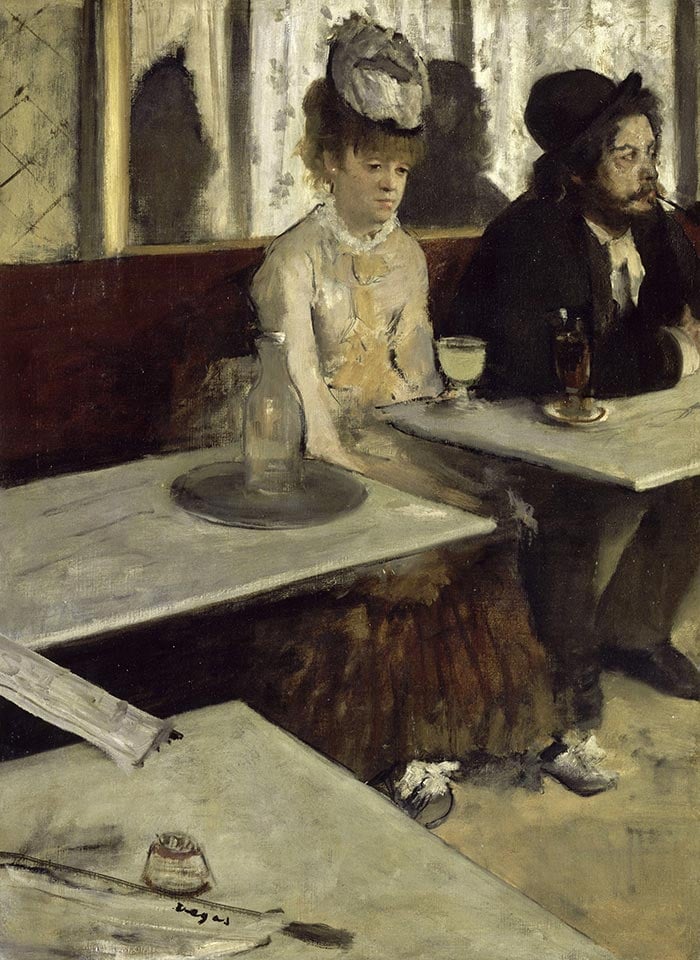
This is such a powerful painting by Edgar Degas. It depicts a disconnected and sad couple. The woman has a pale green drink in front of her, being absinthe. The two subjects were actually friends of Degas. Ellen André was an actress and an artist’s model and Marcellin Desboutin was an artist and engraver. Both their careers took a hit as a result of this painting and Degas had to publicly announce that the two were not actually alcoholics.
There is a lot going on in the painting, yet there is such a feeling of emptiness. I like how Degas used black to outline key parts of the painting – like the woman’s blouse, her shoes and the tables. This adds an interesting stylistic effect to the painting. I also like the strong use of shape in the painting.
Edvard Munch, the Sick Child (Det Syke Barn), 1885

Edvard Munch is famous for his dramatic and evocative paintings. Most people will be familiar with his painting, “The Scream“. But to me, the above painting is much more dramatic.
It features a “sick child” with a parent, family member or close friend. The sick child is actually Munch’s sister, who died from tuberculosis. She is depicted as frail and weak, probably in her last moments.
The brushwork is chaotic and the subjects are distorted. The colors appear muddy and the perspective appears awkward, but this seems to be intentional. It creates a sense of unease in the painting.
Key takeaway: Sometimes it is more effective to paint inaccurately to help render the subject.
Edward Hopper, Automat, 1927

This painting is similar to the earlier painting by Degas in that it features an isolated woman with a gazeless stare. In this case, the woman is sitting alone in an automat. Hopper was depicting the general loneliness and isolation of the individual within the urban society at the time.
An automat is a restaurant where simple food and drink are served by vending machines. This is important as it reiterates the isolation of the subject – she can eat out without having any interaction with other people.
The subject has one glove removed to hold her coffee. This indicates she only intended on a brief stop before she ventured back outside.
Hopper’s wife is thought to have posed as the subject for this painting, but Hopper painted her with younger features.
Francis Bacon, Businessman I, 1952 or Man’s Head, 1952

This confronting painting depicts a subject who is going crazy with the thought of remaining a put-together businessman. This painting is kind of how I felt whilst I was working as an accountant… (kidding, but not really).
The “businessman” looks to be trapped in a glass box, indicating his isolation. He seems horrified by the life he must live, yet stuck within that life.
His face is distorted and the colors are nothing but grays and dull blues. This is not a technical masterpiece, but it is certainly powerful.
Frederick McCubbin, Pioneer, 1904

I remember doing an art assignment on the above painting during high school. The painting is by the talented Australian artist named Frederick McCubbin. He made interesting use of 3 separate panels (known as a triptych) to show the passage of time.
The first panel features a pioneering young couple in the Australian bush. The man is building a fire in the background whilst the woman ponders in the foreground.
The second panel features a couple with a newborn. There is more light showing through the trees in the background and a small house has been built.
The final panel features a male subject who is at a grave. It is uncertain if the subject is the pioneer from the earlier sections, the son of the couple or a stranger passing by. The bush in the background has been cleared and a city is emerging.
Pablo Picasso, Old Guitarist, 1903

This is one of Pablo Picasso’s paintings from his “blue period”, which lasted from 1901 to 1904. The painting seems to be influenced by the Expressionist art movement, his involvement with the poor, his own struggles and the suicide of close friend Carlos Casagemas.
As with most of the paintings created by Picasso during the “blue period”, there is a frail subject rendered with dull blues. The subject is skinny and has elongated features.
He grasps the guitar, which is painted in a dull orange and represents the only significant color shift in the painting. The guitar seems to represent the subject’s only source of living.
Interesting fact: Examinations by curators revealed at least two other paintings underneath the Old Guitarist. Below is an image of one of the subjects in these paintings.

Ilya Repin, Ivan the Terrible and His Son Ivan, 1885

The painting above by Ilya Repin depicts a horrific scene with Ivan the Terrible holding his mortally wounded son, Tsarevich Ivan Ivanovich. It is believed that Ivan the Terrible made the fatal wound. Repin certainly captured the grief-stricken gaze of Ivan the Terrible.
There is a clever contrast between the vivid reds in the foreground and on the subject and the dull and dark greens in the background. The level of detail also focuses your attention on the two subjects.
This is one of Russia’s most famous and controversial paintings. It has been vandalized twice due to its controversy, once in 1913 and once in 2018.
Vincent van Gogh, Sorrowing Old Man (At Eternity’s Gate), 1890

This painting by Vincent van Gogh features a “sorrowing old man” who appears to be at the end of his road. The painting was completed during a health relapse some two months prior to van Gogh’s death.
It was based on a lithograph and several drawings which he created earlier. He said of the drawings:
“Today and yesterday I drew two figures of an old man with his elbows on his knees and his head in his hands. I did it of Schuitemaker once and always kept the drawing, because I wanted to do it better another time. Perhaps I’ll also do a lithograph of it. What a fine sight an old working man makes, in his patched bombazine suit with his bald head.”
What I find interesting about this painting is that it is done with high-key colors. Most of the other dramatic paintings in this post feature dull and dark colors. In true van Gogh style, he went against the grain and painted this dramatic subject with a relatively colorful palette.
Key Takeaways
Here are some of the key takeaways from this post:
- As artists, we are not only trying to paint what is in front of us, but also what is inside us. How does the subject make you feel? What do you want people to feel when they look at your painting? The paintings in this post demonstrate how much emotion you can depict. Obviously, you do not need to paint with such drama. You could simply paint the joy which a landscape makes you feel.
- Color is one of the most effective tools we have as artists for painting emotion.
- Sometimes, it pays to paint inaccurately in order to get your message across. For example, distorting the subject, painting with odd perspective or using muddy colors.
Want to Learn More?
You might be interested in my Painting Academy course. I’ll walk you through the time-tested fundamentals of painting. It’s perfect for absolute beginner to intermediate painters.
Thanks for Reading!
I appreciate you taking the time to read this post and I hope you found it helpful. Feel free to share it with friends.
Happy painting!
Dan Scott

Draw Paint Academy

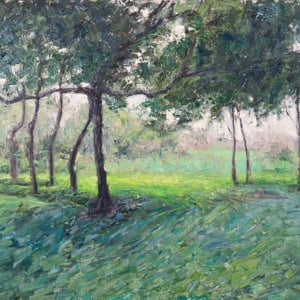

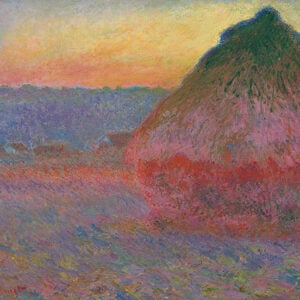

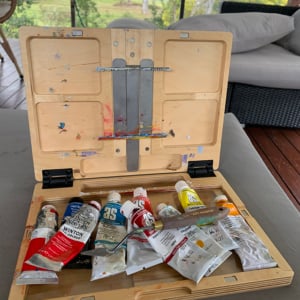
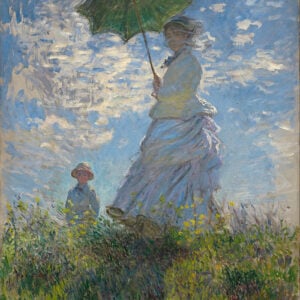
Very educative write up. Thanks
Great,great, more, this was informative,and very enjoyable,please do it again.
This was very generous of you
Thanks! Glad you enjoyed it. Dan
Thanks , as always your comments and fantastic illustrative knowledge fills me with joy and optimism in regards to my own painting journey. Although I can not paint enough due to circumstances at the moment I hope to be able to follow my yearning to paint more and more of what I feel and see . Your e mails are what are keeping me hopeful for the future. Painting is my passion ,as was once photography . (and still is to an extent) These day’s my camera is old fashioned, but my paintings are unique and an extension to my photos . One day I hope they will be something my family can be proud of. Meanwhile I will continue to learn from your e mails Thanks again.
Thanks Margaret. I am trying to get into photography myself but the technology changes so fast! That is why I enjoy painting. It doesn’t change all that much over time. Just paint on canvas. Nice and simple.
Cheers, Dan
You moved me… your one in a melon! Thank You JIH
Thank you Pat!
Picasso dramatised the pinnacle of horror of his world most effectively for me via his ‘Guernica’ whereat not one of those portrayed escapes the terror of the industrial nationalists grinding up blood and bone of the peasant folk in the mechanical war machine of the nazi condor squadron.
Also Francisco Goya’s depiction of Cronos devouring one of his children, partially achieved, thrusts the horror of cannibalism in our face.
Thanks for those additions Ernest. Goya’s painting is particularly confronting. Dan
Found this article very interesting. I feel so much more knowledgeable about art history by reading your e-mails. It inspires me to paint and draw more. As I continue my journey to do my art until who knows when . . .
Thanks Chris! Dan
Please dont ever stop sharing your insite. Those of us who need to feel there is some reason to go on making art are so grateful. You are a good man.
I am mostly self taught as an artist and want to express my gratitude for your emails. I am paying more attention because I am learning from them. Many thanks. Nancy G.
It is my pleasure thanks Nancy! Dan
Thanks for posting this. I have always wondered about some of these paintings and now that I understand what they mean I see them in a different light. Your articles are always interesting. I learn a lot from them.
Thanks Mary, glad to hear. Dan
Thanks. Your lessons and insights have really cultivated my Artwork.
Thanks Jennifer, Dan
Thanks for taking the time to write this. I have been so wrapped up with seemingly important things that I have forgotten to stop and just contemplate art.
My pleasure, thanks Lindy 🙂 Dan
Thanks for a very interesting and educative post! It’s made these famous paintings more meaningful when we see the personal connection of the artist and the subject. Your description of the paintings ( especially Camille On Her Deathbed and The Sick Child ) is very accurate and gave me a fresh insight into these great works of art.
Thanks Sunita, Dan
Great post, Dan! Wyeth’s, Degas’, and Hopper’s examples are also great compositions. The compositions in those three add so much to the drama and emotion of the paintings.
Thanks James, completely agree. Dan
Thank you for sharing your vast knowledge. I’m so interested in art history and being able to understand these treasures.
Thanks Dale! Dan
Please dont ever stop sharing your insite. Those of us who need to feel there is some reason to go on making art are so grateful. You are a good man.
I so look forward to your emails every day. I am learning so much. Thank you.
That is what I like to hear thanks Jackie
I plan to save this post as it was very educational and helps to illustrate the pain and suffering that many of us must face each day. I keep rehearsing in my mind about what I want to convey to my audience in my paintings. Thanks for your wonderful insight into the thoughts of these artists.
Thanks Jean glad to hear, Dan
Thank you so much Dan, for sharing this educational and enlightening post. I am such a beginner that I am merely trying for accuracy at this time and haven’t given a lot of thought to what I want my painting to show others. Keep on keeping on! Thanks again.
Thanks Joan. Yes that is a good thing to focus on. But always nice to have in the back of your mind what emotions you are trying to convey. Cheers, Dan
Wonderful!!!!
Thanks Ann, Dan
Very thought provoking Dan. What a great post. Probably demonstrates the underlying difference between the Masters and us mere mortals when it come to expressing ourselves through the medium of art. Of all the examples and tutorials I’ve seen and done this has influenced my approach to future projects, thank you.
Fantastic thanks John! It does show there are levels to this art game. Dan
I was hesitant to open the mail after you warning but I did and yes, they are disturbing bad not as bad as some of the old Masters. I mean, I can’t take gore and blood too well. And as you said, dramatic effect doesn’t have to be sad dramatic. It can be beautiful and joyful “dramatic.” As much as I appreciate the strong feelings of some artists I will stay with my “happy” and colorful painting intentions.
Thanks so much for another very educating post. You should publish a book.
Thanks Jola. I prefer to just put it out for free. Maybe one day I will write a book – who knows 🙂 Dan
I enjoyed the post as I enjoy all of your posts. I am a portrait painter mostly, but I also do American Scene painting. I am venturing into landscapes. I was trained in a classical style. All of the articles you write have been so interesting to me.I I feel like I’ve taken a day trip to a gallery with a painter friend (you). Thank you so much!
That is what I like to hear! Thanks Lydia, Dan
What an interesting study of paintings, some of whom I have never seen before. The use of colors are what I have gotten the most out of. Very good lesson and I hope to be able to use it in my art work. Thanks, Joann Barry
Thanks Joann. Yes there is much to learn about their subtle use of color. Dan
So interesting! This was such a wonderful “walk through” of the artist’s style and inner emotions. I intend to share this with other artist friends. I sincerely hope you do more of these. Your posts are always so interesting and informative.
Thanks Phyllis! Appreciate the shares. Dan
Thank you Dan as always informative and interesting…
I enjoy getting your emails and they inspire me, and remind me
to take time out to paint!
Awesome thanks Shirley! I need to remind myself sometimes. Dan
Your explanation of each painting made me go back a couple of times for closer observation. I love the insights you shared. Thank you.
Really glad to hear thanks Dianne, Dan
Very interesting
Hi Dan,
The Business Man really got to me. I, too, worked in Accounts Payable at one time and I still occasionally temp if needed. My first love is art and always will be. I hate working in cubicles and refuse to do it full time. I saw that painting and came close to crying as I know that feeling very well. Christina’s World gets under my skin as well as it evokes feelings of isolation and loneliness. This was a very good and thought-provoking post. Thank you!
i can’t thank you enough for all the FREE posts you send. so provoctative instructive and inspiring thank you a million times
Just happy to help Frank! Thanks, Dan
I have never had a desire to paint thus have never had any previous art education and minimal interest of art in itself. Then a new awakening! Am a self taught artist of oil/alkyd using totally the palette knife. Your emails are of particular interest to me as I have much to catch up with. Am energized in front of a blank canvas. Thank you for caring for this new artist. (PS I am 82 years old)
Thank you, Dan! I too feel I have walked through a gallery with a personal guide and friend, giving so much history and insight to the thoughts and technical methods behind the artists! What a blessing to us! Thank you! Your knowledge is well conveyed and so interesting! It touches all the right bases!
One comment on Francis Bacon’s Business Man I … it seems he is trying to escape the “glass window” he can’t get through (perhaps he yearns for the outside as opposed to being stuck inside). His face seems desperately pressed into the glass, even to the extent it may break … that is very powerfully conveyed to me! Thank you, Dan! Keep sending us your knowledge and insight ~ we are learning ~ And reaching for our brushes! Cheers!
thank you for caring enough for us tentative artists to give us your experiences of struggle and growth. we learn as bee paint and grow.
thanks
Thank you for this thought and emotion provoking selection, to which I would like to add the Death of Marat by the French painter David. That one had always given me shivers!
Dan, Thank you for reminding us that ‘inaccurate’ paintings can be so powerful! But painting ‘intentionally inaccurately’ can also be as difficult as painting accurately! Oh, my!
Thank you it is very educational in understanding the paintings. I always wonder what goes thru the mind of an artist when he paints. I enjoy every one of your comments and your insight into their work.
Happy to hear this Mabel! More to come. Dan
Thank you so much, Dan. This is another great educational post for me. Thanks to you for discovering Frederick McCubbin. I enjoy getting your inspiring emails. Congrats.
That is great to hear Michel! Thanks, Dan
I enjoyed this very much. Thank you for taking the time to put this together for our enjoyment and growth.
I have taken art history classes in the past, but this is a wonderful new slant and perspective into the world of art. Something I’ve been missing for many years.
I’m trying to emerge back into a world that has been calling for me, for far too long. I look forward to learning more from you.
Thanks again, for your investment and interest in bringing this together for strangers, such as myself. It’s wonderful knowledge!
No problem at all Shelly! Happy to be helping. Thanks, Dan
Hi Dan!
Re Munch’s Sick Child in the context of dramatic paintings:
Almost always I find myself in complete agreement with your analyses of paintings, but there is one amongst this group with which I beg to differ; The Sick Child.
You use this particular work to illustrate the use of muddy colours to convey negative emotions, and sure, there are muddy colours here and there (foot of the bed, e.g.) but overall I find the colours glorious, brilliant! Such a broad palette, and such strong colours!
What I do notice is the posture of the visitor, who is depicted in blue black. Such a powerful image of suffering, and SHE is the focus of our gaze!
By contrast, the sick girl; Munch’s sister, is full of light and bright colour. Her head is placed above the visitor’s, and her gaze falls down upon her, as if giving a benediction. They are linked by the patch of light from the pillow between, which also surrounds their clasped hands.
I see the dramatic impact here as coming from the comfort that the sick person is willing upon her grieving visitor – what a joyful paradox!
How clever is Munch. 🤗
Thank you for sharing your knowledge & these masterpieces.
No problem Margaret! Dan
So enjoyed this post…so interesting what different subjects these famous artists painted! Some I hadn’t seen before, so thank you for sharing, reminds me that art is what an artist feels inside, and how they portray that is unique from artist to artist. Thanks Dan!
Very true Melanie! Glad you enjoyed the post. Thanks, Dan
Great!!!!!!!
Thanks Ann! Dan
powerful examples – thanks.
Hi Dan, I found this all so interesting!! I looked for the painting underneath the man’s face and found the other face etc etc. I certainly have a long way to go but I am going to try and paint with joy. It is my most favourite thing to do…painting but I find I can only do it for about an hour and a half at a time.
We are South Africans but visit our children in Australia and drive between Sydney and Adelaide. The scenery is amazing. Specially when there is the bluest of skies then the wheat colour fields and then rusty red soil. Beautiful. One day I want to capture those contrasts. Also passed a farm a couple of times where people have hung the most amazing colour footwear. Too detailed for me but so interesting as a subject. I’ve only mentioned these two but there are so many interesting places to paint. The one time we took photos of dead trees wherever we went trying to find the perfect shape. We were questioned at a coffee caravan what we were up to by a woman traveler who kept on seeing us stopping. When we told her she walked off with an expression that said very loudly’ mad people. But it was fun. Stil haven’t tried to paint any of these scenes as landscapes scare me. But I will get there.
Thank you. I hope to sometime soon get your e-book.
Hello again Dan,
What you’ve chosen to show are among many of my favourites. It’s true isn’t it – savage or serene, the only thing that kills it is indifference. Thank you for reminding me.
Dulcie
Degas – Re your comment about the strong shapes & black outline of the woman’s dress.
Somehow the black edge in an image fools our minds that there is depth, so that Absinthe arm appears to be a little away from the back of the bench, as does the black coat of the man. The shadow of the man on the bench makes it more effective (I think).
Van Gogh’s blue outline, black does the job better, doesn’t have the same effect & probably not intended to.
So I think that the black outline or edge gives strong shapes that standout in 3D. Your thoughts?
I’ve learned more from your emails than I ever learned in school. I wish I had been a better H.S. art teacher. Have taken up painting again, thanks to your inspiration. Pat
I’ve learned more from your emails than I ever learned in school. I wish I had been a better H.S. art teacher. Have taken up painting again, thanks to your inspiration. Pat
I have always loved Frederick McCubbin’s tryptich painting after viewing it at an exhibition called Golden Summers at The Sydney Art Gallery. I love that it tells a story & shows the muted greens of the Australian bush. I have a large print of this painting in my dining room & enjoy gazing at it whilst at the table.
I’ve learned a great deal from all your posts. It makes my own painting experience far more meaningful. Thank you!
How about David’s Death of Marat for emotional content.
I liked very much the first one and the name of painting style magic realism!!!1
Love your comments on different artists. It’s making me really look at my work emotionally and not just artistically.
Thanks Dan x
As others have stated, you interpretations and analyses of the works are interesting and thought-provoking… as a former studio art major with a minor in art history, its fun to see different interpretations of various works.
Thanks for the insight, as well as sharing helpful painting tips! 🙂
Some very interesting picks. My greatest memories of art paintings were of the numerous prints of Hans Haysen works hanging all-around the family home. Along with that was the notion that an original Haysen work owned by a member of the family was on permanent loan to the WA art gallery. Who knows if that is true. The other major art installation from memory was of Jackson Pollock’s Blue Polesq and the furore that surrounded it being bought for such a mammoth amount. The 70’s and Gough Whitlam are still remembered. I am only now taking an interest in Art after being lambasted by my Form 2 Art Teacher and having him draw his wants on my own drawings that I had taken a long time pouring my heart into them. I took up crafts later in life and left that after a move to another state. I shall let my path lead me where it will from now on.
Last year I studied the history of art which I enjoyed very much, however, for someone with your knowledge to explain these art pieces opens up another door. Since I have taken up painting it also helps you look at art with a different perspective. Thank you Dan for taking the time
Excellent descrptions. I learned a lot. Just a beginner, but becoming more observant.
Thank you for keeping giving painting tips.
This was so interesting, and helpful. I love learning about the paintings and artists from your emails, and it makes me more observant about what the artist is doing to convey meaning and feeling. Thanks for taking the time to do these-
thank you so much for ur insight. it gives me a reason for living.
Very informative and helpful. Pointing out how the artist made use of color and light helped heightened an appreciation of effective techniques. Your comments unsighted a spark in my heart that I hope to explore and attempt in my form of application. Thank you for sharing your expertise, time and energy.
I have had the pleasure of seeing the Old Guitarist which is one of my favorite paintings. I was studying it at the Art Institute in Chicago. I found this to be an emotionally sad painting and the blues accented that feeling. Thank you for all the informative writings.
This was a wonderful read! Thanks for posting it.
We’ve had the “Old Guitarist” painting for decades, and I never knew about the picture shown in the article underneath. I looked at our copy of the painting, and sure enough, I can see the outline.
Two months ago, I went to the Van Gogh immersive experience in Washington, DC. “The Sorrowing Old Man” was moving in the picture, and he moved with such grief and sorrow that even now it brings tears to my eyes.
Wonderful article, a really good read.
Thanks 💛
Nice Artwork Paintings – I believe everybody would like to have a painting on his wall
Great article and perfect choices of art work. Check out my Pinterest site at “jamesmeaders1.” Might find something you like.
Those are true artworks! – Nice
Hi Dan
Your emails and comments are making me getting closer to painting. I always loved painting, my father used to paint quite a lot but I favoured photograpy more because it can capture an emotion in a second
But now I am beginning to realise, thanks to you, that painting can do that better as it involves the ‘self’.
In fact I’ve started a dramatic painting Death of Hypatia which is the very first for me. I wish if someone can give me some hints about it. I am a senior painter (sic) and this maybe is the first and last one. That is why I am trying to make it as dramatic as possible.
God bless.